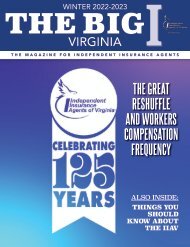The Big I Virginia Summer 2020
Create successful ePaper yourself
Turn your PDF publications into a flip-book with our unique Google optimized e-Paper software.
An employee uses marijuana legally
over the weekend but then fails a
random drug test on Monday. The
legalization of marijuana has created
issues when it comes to drafting and
implementing employment policies.
Since marijuana shows up as a
positive result for much longer than
the employee is under the influence,
it is hard to know when and how to
discipline. In some situations, you
may need to witness several side
effects of the employee being under
the influence regardless of the drug
test result. In others, any positive
result is ground for termination, such
as in states where the substance
is illegal or you are controlled by a
zero-tolerance policy based on a
federal contract.
An employee acts inappropriately
during a conference in front of
co-workers, vendors, clients,
and prospects, becoming loud
and “un-PC.” The employee is
representing the company so this
unacceptable behavior could cost
the company money, reputation, and
clients. More serious actions such
as revealing classified information,
harassing/sexually harassing an
employee, client, or vendor, telling
inappropriate jokes, or using
unacceptable language should
result in serious discipline. Note: The
employee cannot use “being drunk”
as an acceptable defense. They are
still responsible for their actions and
possibly restricting alcohol in future
events may be appropriate.
An employee complains about
their low wages (posting how
much they make) and how awful
their supervisor is. Some speech
like this is protected under the
National Labor Relations Act (NLRA).
Under the NLRA, all employees have
the right to exercise “protected
concerted activity” which is speech
or actions with the purpose of
improving working conditions for
themselves and others. Employees
talking about their own work
conditions is protected; talking
about others without permission
is not. It is also not protected to
violate confidentiality such as the
company’s pricing structure or client
information.
An employee is arrested for their
part in a barroom brawl involving
their friends and some strangers.
In most situations, you cannot
take action on an arrest alone.
However, if the charge is serious
enough that the employee will be
missing significant time (i.e., they
cannot report to work because they
are in jail) then you may have the
option to terminate for unexcused
absences. If the charge involves
violence, you may have options
for discipline if there is legitimate
concern it could migrate into the
workplace. If other employees were
involved, you may need to evaluate
the workplace situation since there
may be harassment or workplace
violence implications evolving from
an unaddressed situation.
An employee uses their personal
social media accounts to post
derogatory messages which
customers have complained about.
Somehow people have connected
this employee and their opinions to
your company so you may be “guilty
by association.” Even though the
employee is using their personal
accounts, presumably on their own
time, their actions are now impacting
your business. This behavior could
impact your company’s reputation,
make customers take their business
elsewhere, and make your other
employees feel uncomfortable. You
cannot make a knee-jerk decision
but should evaluate all the factors,
including the employee’s work
performance, tenure, etc., and
determine the best course of action
including perhaps disciplinary action
or even termination.
An employee who works in
purchasing comes to the office
Monday talking about the great
time they had with a potential
vendor at a sporting event
including luxury box seats, a full
bar, and a meet-and-greet with
the team. While on the surface
there seems to be nothing wrong
here, you need to consider all the
potential outcomes arising from this
situation. An employee accepting
such a valuable gift could create a
spoken or unspoken expectation
to steer your company’s business
to their company. If they have
any power over the decision, the
impartiality of their decision-making
could come into question, possibly
committing your company to a costly
relationship that does not work for
you. Having a Conflicts of Interest
policy outlining what is and is not
acceptable can help you ensure that
employees are making decisions for
the right reasons.
Please note that all situations
differ based on factors such as
the employee’s circumstances, the
company’s past precedent, state
and local laws, employment-at-will
status, and/or collective bargaining
agreements. Therefore, before you
discipline or fire an employee for offduty
conduct, you want to assess:
• Is the employee an at-will
employee?
• Did the employee engage in
protected activity, such as that
protected by the NLRA?
• Are there any federal, state, or
local laws that may apply?
And before you take action, it is best
to do a full investigation, listen to all
sides involved and, when in doubt,
check with your legal counsel or call
us at Affinity HR Group to help walk
you through it.
Paige McAllister is a contributor for
Affinity HR Group, Inc., IIAV’s affiliated
human resources partner. Affinity
HR Group specializes in providing
human resources assistance to
associations such as IIAV and their
member companies. To learn more,
visit www.affinityHRgroup.com.
SUMMER 2020 THE BIG VIRGINIA 33

















